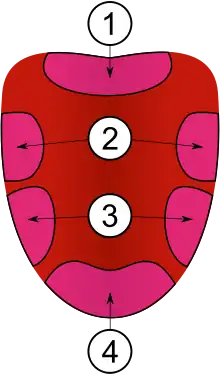Солодкий смак
Солодкість — один з чотирьох (або п'яти) «основних смаків», що традиційно розрізнювались людьми в різних країнах та культурах.

Наявність солодкого смаку зазвичай асоціюють із присутністю цукру, але відчуття солодкого виникає також від гліцерину, деяких білкових сполук, амінокислот (аспартам). Одним з хімічних носіїв «солодкого» є гідрокси-групи в великих органічних молекулах — розчинні вуглеводи, а також поліоли: сорбіт, ксіліт.
Рецептори солодкого
Рецептори солодкого — G-протеїни — особливо щільно розміщені на язиці в певних зонах. Використовується система «вторинних посередників» цАМФ, пов'язана з H+-каналами, рецепціею «кислого смаку».
Солодкі речовини різної природи можуть мати різні додаткові тони смаку, наприклад сахарин тільки в найменших концентраціях сприймається, як солодке, а при більших — має чіткий «металевий присмак».
| Молекула | Поріг |
|---|---|
| Цукроза | 10 mM |
| Лактоза | 30 mM |
| 1-пропіл-2-аміно-4-нітробензол | 2*10-3 mM |
Див. також
Посилання
- Cohn, Georg (1914). Die Organischen Geschmackstoffe. Berlin: F. Siemenroth.
- Kier L (1972). Journal of Pharmaceutical Science 61: 1394.
- Kitagawa M, Kusakabe Y, Miura H, Ninomiya Y, Hino A (2001). Molecular genetic identification of a candidate receptor gene for sweet taste. Biochemical and Biophysical Research Communications 283: 236–242.
- Li XD, Staszewski L, Xu H, Durick K, Zoller M, Adler E (2002). Human receptors for sweet and umami taste. Proceedings of the National Academy of Sciences of the United States of America 99: 4692–4696.
- Max M, Shanker YG, Huang LQ, Rong M, Liu Z, Campagne F, Weinstein H, Damak S, Margolskee RF (2001). Tas1r3, encoding a new candidate taste receptor, is allelic to the sweet responsiveness locus Sac. Nature Genetics 28: 58–63.
- Montmayeur JP, Liberles SD, Matsunami H, Buck LB (2001). A candidate taste receptor gene near a sweet taste locus. Nature Neuroscience 4: 492–498.
- Nelson G, Hoon MA, Chandrashekar J, Zhang YF, Ryba NJP, Zuker CS (2001). Mammalian sweet taste receptors. Cell 106: 381–390.
- Nofre C, Tinti JM (1996). Sweetness reception in man: the multipoint attachment theory. Food Chemistry 56: 263–274.
- Sainz E, Korley JN, Battey JF, Sullivan SL (2001). Identification of a novel member of the T1R family of putative taste receptors. Journal of Neurochemistry 77: 896–903.
- Shallenberger RS (1963). Hydrogen bonding and the varying sweetness of the sugars. Journal of Food Science 28: 584–589.
- Tinti, Jean-Marie & Nofre, Claude (1991). Why does a sweetener taste sweet? A new model. In D.E. Walters, F.T Orthoefer & G.E. DuBois (Eds.), Sweeteners: Discovery, Molecular Design, and Chemoreception, ACS Symposium Series 450, pp. 209—213. Washington, DC: American Chemical Society.